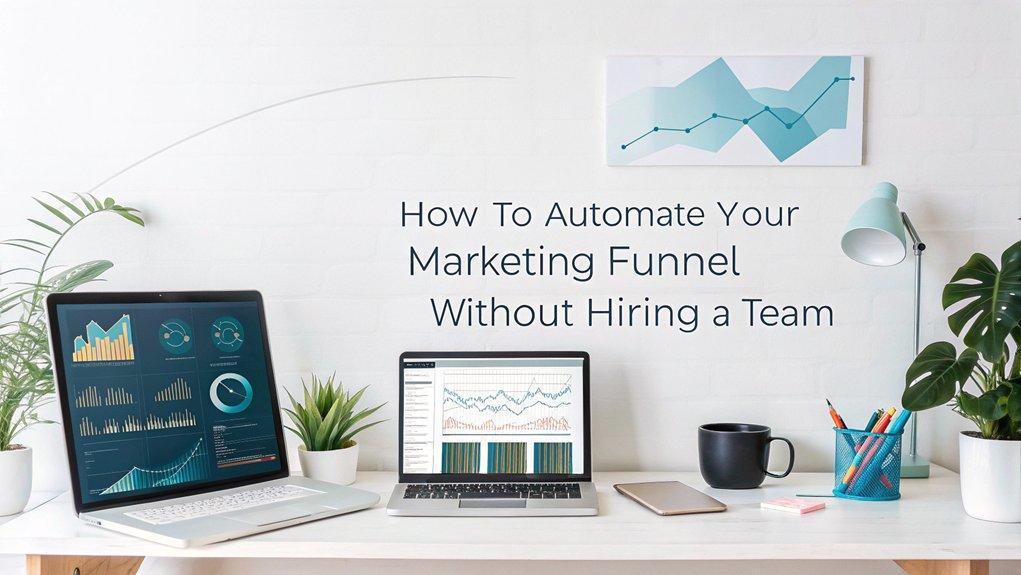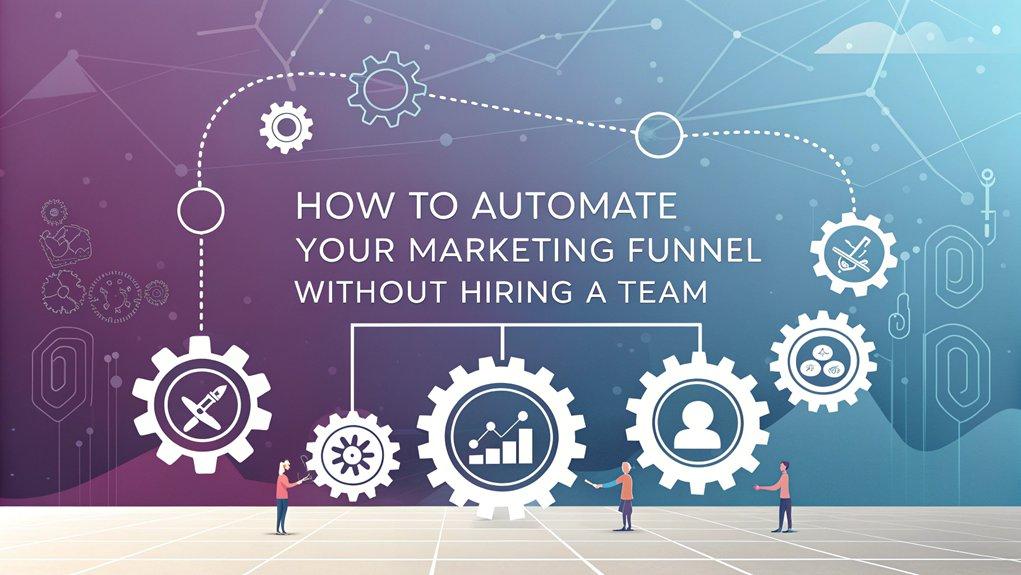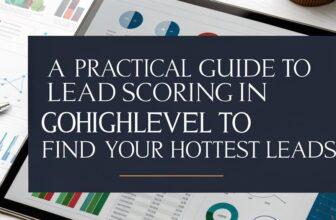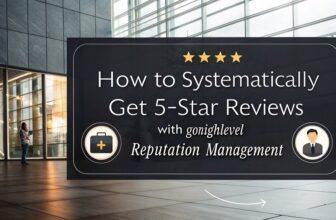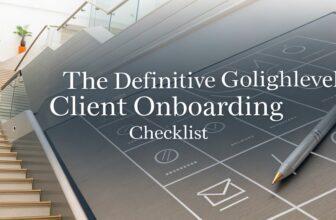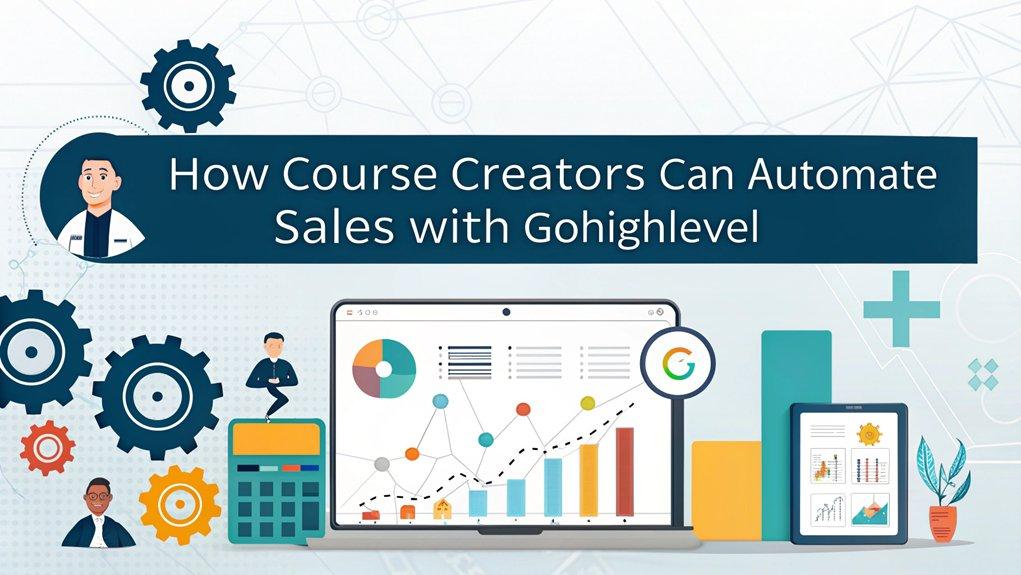Automate your marketing funnel by leveraging user-friendly platforms like GetResponse or MailChimp. Set clear objectives and segment your audience based on behavior and interests for tailored messaging. Develop intuitive automated workflows and design engaging content with a unique value proposition. Monitor open and conversion rates, using analytics for optimization. Avoid pitfalls by balancing automated processes with personal interactions. Implement these strategies effectively to see your marketing efforts succeed even without a team. Explore further for in-depth strategies.
Key Facts Summarized
- Use user-friendly platforms like MailChimp for intuitive marketing automation without needing specialized skills.
- Leverage audience segmentation to personalize content and improve engagement without additional staff.
- Implement A/B testing to optimize messaging and offers efficiently on your own.
- Utilize pre-built templates to quickly set up campaigns and streamline automation processes.
- Regularly analyze performance metrics to make informed adjustments and enhance funnel effectiveness independently.
Understanding Marketing Funnel Automation
Understanding marketing funnel automation is crucial for optimizing your customer journey. You can streamline the path from awareness to action by leveraging email marketing automation and lead nurturing techniques.
Segment your audience to deliver personalized content and increase engagement. Social media automation helps maintain a consistent presence, enhancing brand visibility.
By using analytics, you can measure performance and refine strategies, aiming to improve conversion rates, which average around 3.6% across industries. Developing automated workflows ensures efficiency, allowing you to focus on strategic planning rather than repetitive tasks. Engaging content is crucial for connecting with the target audience, ensuring that your automated efforts resonate effectively.
However, maintaining data accuracy is essential to avoid impersonal interactions. Integrating these components effectively will optimize your marketing efforts, making every stage of the funnel more effective and aligned with your business objectives.
Identifying Your Goals and Target Audience
To effectively automate your marketing funnel, start by setting clear objectives, such as boosting lead generation by 20% or cutting customer acquisition costs.
Analyze your target audience’s behavior through data-driven insights like demographics and pain points from market research.
Use this information to align your automation strategies with precise content and channels, enhancing engagement and conversion rates. Understanding audience needs and demographics is crucial for ensuring your automation efforts resonate with potential customers.
Defining Clear Objectives
When setting the stage for automating your marketing funnel, it’s crucial to define clear objectives to guide your strategy effectively. Start by establishing measurable goals like increasing lead conversion rates by 20% within six months. Use SMART goals to ensure your objectives are actionable and aligned with your target audience through buyer personas.
| Objective | Methodology | Outcome |
|---|---|---|
| Increase conversion | SMART goals | Enhanced performance |
| Identify target audience | Buyer personas | Tailored messaging |
| Measure performance | Performance analytics | Continuous improvement |
| Understand preferences | Market research | Better engagement |
| Adjust objectives | Regular reviews | Evolving strategies |
Leverage performance analytics to continually refine your funnel, aligning with customer preferences and market trends. This strategic planning ensures your marketing efforts remain effective and adaptable.
Analyzing Audience Behavior
As you delve into analyzing audience behavior, leveraging data from user interactions becomes crucial in identifying patterns and preferences that inform your marketing strategy.
Begin by analyzing data from platforms like Google Analytics to understand user interactions. Effective segmentation based on behavior and demographics allows for tailored messaging that resonates with specific groups, boosting conversion rates significantly.
Tools like heatmaps provide a visual representation of audience behavior on your site, helping identify areas of interest or frustration. Complement these insights by gathering qualitative data through surveys or feedback forms to refine your marketing strategy further.
Leveraging User-Friendly Automation Platforms
Although navigating the world of marketing automation can seem daunting, leveraging user-friendly platforms like GetResponse and MailChimp simplifies the process significantly.
These platforms empower you to build an automated marketing funnel with minimal effort. By utilizing pre-built templates and workflows, you can rapidly deploy complex email sequences and lead nurturing campaigns. Integration with CRM systems ensures seamless lead management and data synchronization.
Key benefits include:
- Drag-and-drop interfaces: Design your campaigns intuitively.
- Performance metrics tracking: Optimize by monitoring open and conversion rates.
- Cost-effective plans: Avoid the expense of hiring a full-time team.
- Pre-built templates: Execute campaigns swiftly without coding.
- Email sequences: Automate communication for efficient lead nurturing.
Additionally, using content repurposing strategies can enhance your marketing funnel’s effectiveness by reaching diverse audiences through optimized messaging.
Crafting Effective Messaging and Content
Crafting effective messaging and content is pivotal in capturing your audience’s attention and guiding them through the buyer’s journey.
Start by understanding your target audience’s pain points and desires. This insight allows you to tailor messaging that resonates and engages.
Highlight your unique value proposition to differentiate your brand, clearly articulating why prospects should choose you.
Leverage storytelling techniques to foster emotional connections, enhancing engagement.
Employ data-driven content creation by analyzing high-performing topics and formats to boost email campaign metrics like open and click-through rates.
Utilize A/B testing on elements like headlines and calls-to-action for continuous optimization, ensuring your messaging aligns with audience preferences and drives conversions.
Regular updates through data analysis ensure that your understanding of the audience remains accurate and relevant.
Strategic planning and precise execution will elevate your marketing funnel’s effectiveness.
Implementing Lead Generation Strategies
To effectively generate traffic, you should employ targeted ads and SEO strategies that attract potential leads to the top of your funnel.
Craft compelling offers using lead magnets like eBooks or webinars, which can increase conversion rates by exchanging valuable content for contact details.
Utilize content marketing to nurture these leads with personalized, automated email sequences, leveraging analytics to refine your approach and optimize engagement rates. Additionally, understanding demographic characteristics can help tailor your lead magnets to better resonate with your audience.
Effective Traffic Generation
How do you ensure your marketing efforts capture the right audience and convert effectively? Start by focusing on effective lead generation.
Utilize personalized content to engage potential customers, increasing conversion rates by up to 300%. Implement lead magnets like free eBooks, aligning them with your audience’s needs for higher engagement.
Prioritize SEO optimization to drive organic traffic, making it a sustainable strategy. Paid traffic strategies, such as Facebook Ads, can boost immediate brand visibility and secure up to 50% of sales.
Segmenting leads allows for targeted messaging, increasing the likelihood of conversions.
- Personalize content for effective lead engagement.
- Use lead magnets to enhance capture.
- Optimize SEO for organic traffic generation.
- Leverage paid traffic strategies for immediate impact.
- Segment leads for tailored, resonant communication.
Crafting Compelling Offers
Although many businesses understand the importance of offers, crafting compelling ones requires a strategic approach rooted in data and differentiation.
Start by identifying your unique value proposition to stand out in lead generation. Use lead magnets like free eBooks or webinars to entice personalized customers, providing immediate value in exchange for contact details.
Employ audience segmentation to tailor offerings, ensuring your message resonates with each group. Incorporate persuasive elements such as testimonials, scarcity, and clear calls-to-action to boost conversions.
Regularly analyze performance using A/B testing and engagement metrics. This data-driven approach lets you refine strategies and optimize lead generation continuously.
Utilizing Content Marketing
When executed strategically, content marketing serves as a cornerstone for effective lead generation, driving traffic by 131% and fostering brand trust through educational resources like articles and videos.
By automating and optimizing your content marketing efforts, you can effectively nurture leads through the marketing funnel. Implement lead magnets, such as eBooks or checklists, to capture potential customer information. This approach will generate a higher engagement rate, with leads 50% more likely to purchase after consuming educational content.
Consistently refine content strategies using analytics to ensure relevance and effectiveness.
- Create a content hub to improve search engine indexing.
- Utilize lead magnets for capturing potential leads.
- Provide valuable educational content to increase engagement.
- Leverage analytics to refine strategies.
- Automate nurturing leads through the funnel.
Designing Automated Workflows
Designing automated workflows is a strategic process that hinges on effectively mapping the customer journey and pinpointing key engagement touchpoints. Use marketing automation tools like GetResponse or HubSpot to tailor personalized emails based on subscriber behavior. Segment your audience to enhance engagement rates, as targeted messaging can boost open rates by 14% and click-throughs by 10%. Implement A/B testing to refine subject lines and content, leveraging performance data for ongoing optimization. Monitor metrics like open and conversion rates to adjust strategies, ensuring your funnel’s effectiveness. Here’s a quick comparison:
| Aspect | Benefit | Tool Example |
|---|---|---|
| Segmentation | Higher engagement rates | HubSpot |
| A/B Testing | Improved performance | GetResponse |
| Monitoring Metrics | Strategic adjustments | Performance Data |
Additionally, understanding audience interests and needs can significantly enhance the effectiveness of your automated workflows. Refine your approach continually for maximum results.
Utilizing Behavioral Triggers for Personalization
By leveraging user actions, you can tailor email content through behavioral triggers, optimizing engagement with targeted messages. Strategic use of “if/then” rules enables dynamic segmentation, ensuring that communication resonates with individual interests and behaviors. This approach not only boosts open and click-through rates significantly but also enhances the customer journey, driving higher conversion and retention rates. Furthermore, understanding your target audience is essential for crafting messages that truly resonate with potential customers.
Leveraging User Actions
Unlocking the potential of behavioral triggers in marketing automation can transform your engagement strategies. By integrating user actions into your automated sales funnel, you can craft personalized content that resonates with your audience.
Implement if/then rules to automate responses, ensuring timely communication with prospects. This approach not only boosts conversion rates but also enhances customer experiences.
Consider these strategic actions:
- Monitor user actions: Track page visits, email opens, and clicks to tailor content.
- Automate follow-ups: Use if/then rules for actions like resource downloads or cart abandonment.
- Enhance segmentation strategies: Deliver content that addresses specific audience pain points.
- Improve conversion rates: Leverage personalized interactions to increase transactions sixfold.
- Ensure timely communication: Be the first responder to capture up to 50% of sales.
Tailoring Email Content
Integrating user actions into your automated sales funnel sets the stage for crafting highly personalized email content. By leveraging behavioral triggers such as email opens, link clicks, and page visits, you can automate everything from sending personalized emails to creating targeted email sequences.
This strategic approach allows you to nurture leads more effectively, guiding them through the funnel with tailored content that directly addresses their specific interests and needs.
Data shows that personalization using behavioral data can boost email open rates by 26%, enhancing engagement significantly. Moreover, implementing automated workflows for scenarios like cart abandonment or content downloads can increase conversion rates by up to 70%.
Effective audience segmentation based on these triggers will improve email campaign performance, ultimately driving higher conversion rates.
Dynamic Segmentation Techniques
While leveraging dynamic segmentation techniques, you can categorize leads in real-time based on behavioral triggers such as website interactions, email engagement, and purchase history.
This approach enhances personalization and optimizes lead nurturing. By implementing these strategies, you can automate segment updates, ensuring relevance without manual effort.
Consider these strategic actions:
- Increase email open rates by 29% and click-through rates by 41%
- Tag users based on actions like abandoned carts or content downloads
- Employ targeted follow-up sequences tailored to individual needs
- Automate messaging for timely interactions and improved conversion rates
- Experience a 20% rise in lead-to-customer conversion rates over static methods
Dynamic segmentation is a data-driven, strategic tool to elevate your marketing funnel’s efficiency.
Monitoring and Optimizing Funnel Performance
Effective funnel performance monitoring and optimization hinge on your ability to analyze and adapt to key metrics like open rates, click-through rates, and conversion rates. Harness automated workflows and marketing analytics tools to continuously monitor performance data. This allows you to pinpoint drop-off points and improve engagement. Implement A/B testing for elements like subject lines and calls-to-action to optimize conversions. By focusing on ongoing optimization, you ensure your content remains relevant and aligned with user needs at each funnel stage. Incorporating structured data into your content can further enhance how search engines interpret your funnel information.
| Key Action | Benefit |
|---|---|
| Analyze Key Metrics | Identify areas for improvement |
| Use Automated Workflows | Streamline monitoring processes |
| Implement A/B Testing | Optimize engagement and conversion |
| Track with Analytics | Pinpoint drop-off points |
| Refine Continuously | Enhance funnel effectiveness |
Set up feedback loops to refine future strategies effectively.
Avoiding Common Automation Pitfalls
Having established a solid foundation for monitoring and optimizing your marketing funnel, it’s important to address potential automation pitfalls that can undermine your efforts.
Over-automating can erode personalization, reducing customer engagement. Balance your automated workflows by integrating genuine interactions.
Remember to segment your audience effectively; generic messaging won’t resonate with every segment. Use behavior and interests for targeting.
Regularly analyze metrics to refine strategies and avoid stagnation. Base decisions on performance metrics, not gut feelings, to ensure effective marketing campaigns.
Simplify automation processes; overly complex funnels can confuse users and hinder conversions.
- Balance automation with genuine interactions
- Segment your audience based on behavior and interests
- Continuously analyze metrics for improvement
- Rely on performance metrics, not intuition
- Simplify automation processes for clarity
Additionally, leverage analytics for audience segmentation to create tailored marketing experiences that resonate with different user groups.
Exploring Real-Life Success Stories
How can real-life examples illuminate the transformative power of marketing automation?
Consider businesses achieving a 451% increase in qualified leads using marketing automation software, a testament to its efficiency.
HubSpot’s strategic use of automated email campaigns boosted sales productivity by 20%, nurturing leads through behavior-based triggers.
E-commerce brands have seen up to a 15% recovery rate with automated cart abandonment emails, enhancing customer success without extra staff.
In real estate, automated lead generation tools save agents 10 hours weekly, shifting focus to deal closures.
A small business case study showed a 30% rise in conversion rates within three months through automated workflows.
These examples highlight how automation can elevate your marketing funnel’s effectiveness strategically. Moreover, leveraging content optimization techniques can further enhance the performance of automated campaigns.
Frequently Asked Questions
How to Automate Your Sales Funnel?
You can automate your sales funnel by implementing marketing automation tools that guide prospects through stages like Awareness and Action.
Focus on email marketing automation to enhance lead nurturing, leveraging real-time data analysis and lead scoring to prioritize high-quality leads.
Use lead magnets at each funnel stage to capture contact info effectively.
Integrate platforms for personalized communication, streamlining repetitive tasks, and optimizing strategies, all while maintaining efficiency and saving resources.
Can I Use AI to Create a Sales Funnel?
Yes, you can use AI to create a sales funnel.
AI analyzes customer behavior and preferences to tailor content and messaging effectively. Tools like HubSpot and ActiveCampaign automate lead scoring and nurturing, while AI-driven chatbots engage prospects, qualify leads, and guide them through the funnel.
With predictive analytics, you can identify drop-off points and adjust strategies proactively. This approach reduces manual workload, ensuring 24/7 operation and consistent lead engagement.
How Do You Automate a Marketing Strategy?
To automate your marketing strategy, start by selecting robust marketing automation software.
Define workflows and triggers based on user actions like sign-ups or cart abandonment.
Segment your audience to deliver personalized content that boosts engagement.
Use analytics to monitor key metrics such as open and conversion rates, and refine your strategy accordingly.
Incorporate lead magnets to capture contact info and implement automated follow-up sequences to nurture leads effectively.
What Are the 5 Stages of the Marketing Funnel?
You’ll navigate five stages in the marketing funnel: Awareness, Interest, Desire, Action, and Loyalty.
Start by grabbing attention through channels like social media, educating prospects about their problems.
Engage their curiosity with in-depth resources during the Interest stage.
Build trust in the Desire stage with testimonials.
Facilitate conversions in the Action stage with clear calls-to-action.
Finally, nurture customer loyalty with effective follow-up strategies, ensuring repeat business and long-term engagement.
Conclusion
By automating your marketing funnel, you can efficiently nurture leads and drive conversions without needing a full team. You might worry about the complexity of automation, but user-friendly platforms simplify the process, letting you strategically focus on crafting personalized, data-driven content that resonates with your audience. Stay vigilant in monitoring performance and optimizing strategies. With strategic planning and leveraging behavioral triggers, you’ll enhance your marketing efforts and achieve measurable success, as demonstrated by real-life success stories.

